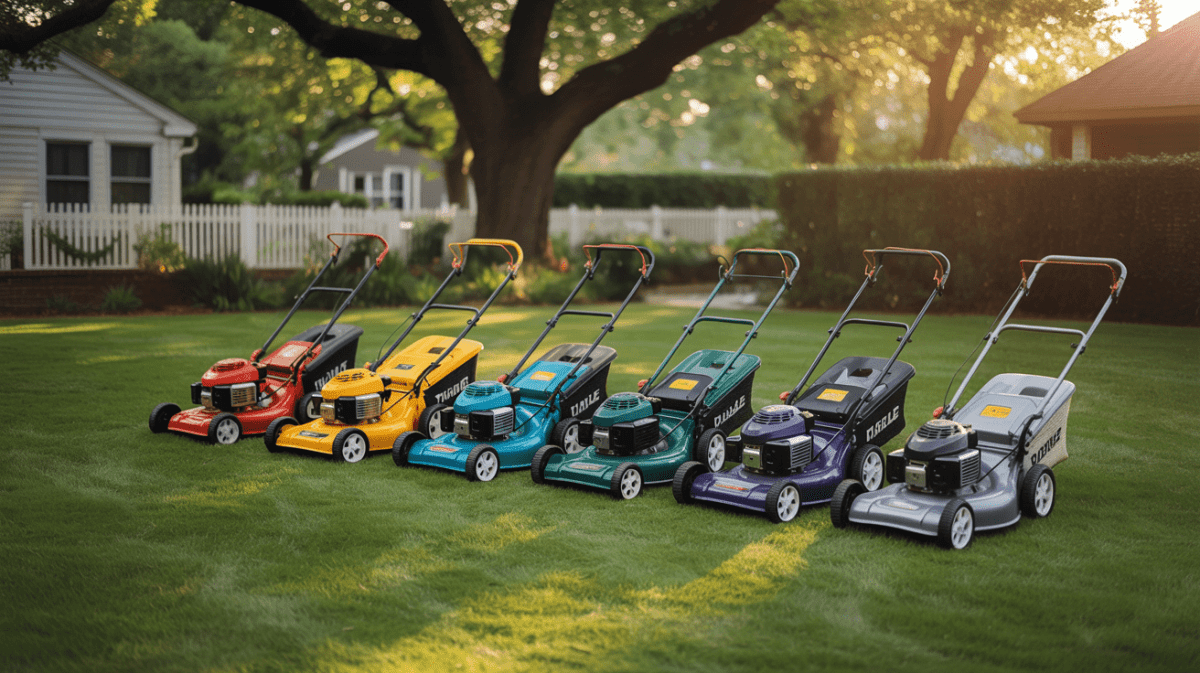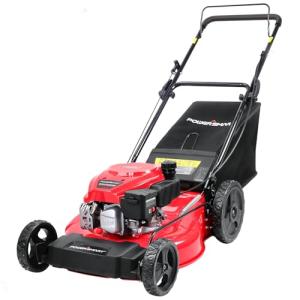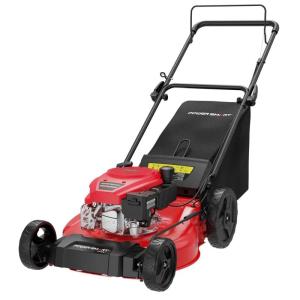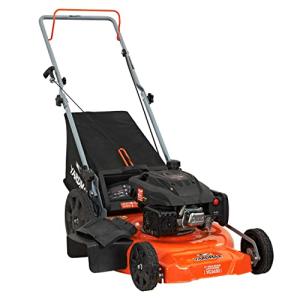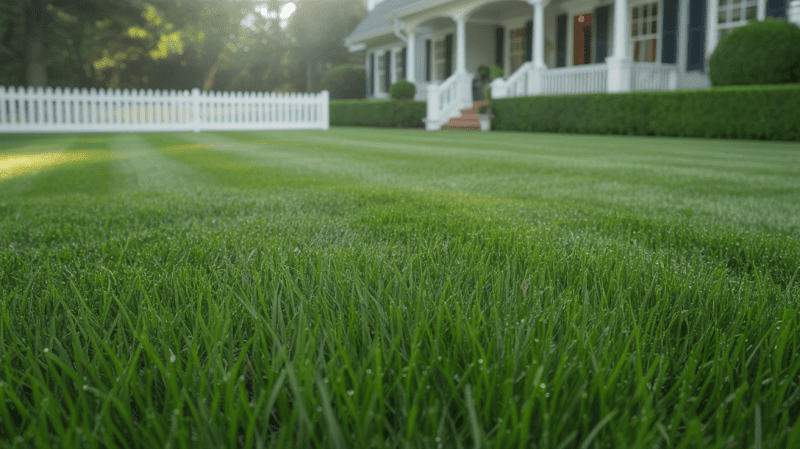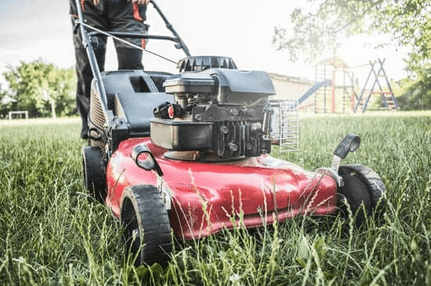Top tips to find the perfect push mower for your yard:
Finding the right push mower can seem hard with so many choices. However, by considering a few key factors, you can select the best one for your lawn.
Consider the mower type, lawn size, and terrain when selecting a push mower. For example, a small lawn needs a smaller mower. However, a large lawn requires something stronger.

Key Takeaways
- Consider the type of mower that is suitable for your lawn's size and terrain.
- Assess your lawn's specific needs to choose the right mower.
- Look for a mower that is compact and lightweight for smaller lawns.
- Choose a more powerful mower for larger lawns.
- Consider the terrain of your lawn when selecting a push mower.
Understanding Different Types of Push Mowers
Choosing the right push mower is key. The type you pick affects your lawn care experience. It depends on the size of your lawn, its terrain, and your personal preferences.
Manual Reel Mowers
Manual reel mowers are perfect for small, flat yards. They are eco-friendly, needing no fuel or electricity. They are also lightweight and easy to move around.
These mowers give a clean cut and are very quiet. They are great for homes.
Gas-Powered Push Mowers
Gas-powered push mowers are good for bigger areas. They have more power than manual mowers. You can pick from different engine sizes to meet your needs.
Electric and Battery-Powered Push Mowers
Electric and battery-powered mowers are quieter and more environmentally friendly. They are lighter and start easily. This makes them a popular choice for many.
But, their use is limited by the battery's life.
Self-Propelled vs. Standard Push Models
Self-propelled mowers make mowing easier, as they move independently. This is ideal for large lawns or for those who find manual mowers difficult to use. Standard mowers need you to push them.
Assessing Your Lawn Size and Terrain
Choosing the right push mower starts with knowing your lawn's size and terrain. The size and layout of your yard are key factors in selecting the best mower for you.
Small Lawns vs. Medium-Sized Lawns
For small lawns, under a quarter acre, a manual reel mower or a compact electric mower works well. They are lightweight, easy to use, and environmentally friendly. However, medium-sized lawns, ranging from a quarter to half an acre, require a more powerful electric or a lightweight gas mower to cut the grass efficiently.
Flat vs. Hilly Terrain Considerations
Lawns with flat terrain are easy to mow with most push mowers. But hilly or uneven terrain requires a mower with more power and traction, like a self-propelled model. This ensures safe and effective mowing on slopes.
Obstacles and Landscaping Features
Obstacles like trees, gardens, and landscaping features affect mowing. A mower with a smaller cutting width and good maneuverability is best for these. Look for a mower with adjustable handlebars for comfort and control.
Engine Power and Performance Specifications
When choosing a push mower, consider its engine power and performance specifications. The engine is key to cutting grass well.
Horsepower and Torque Ratings
Horsepower indicates the engine's power, while torque represents its rotational force. More horsepower and torque mean better cutting, especially in thick grass.
2-Cycle vs. 4-Cycle Engines
Two-cycle engines are lighter and simpler, but they require a mixture of oil and fuel. Four-cycle engines are more common, use fuel more efficiently, and are greener.
Electric Motor Power Ratings
Electric mowers rely on motor power ratings. These are in volts or amps. Higher ratings mean motors can handle thicker grass.
Starting Mechanisms
The starting mechanism affects how easily the mower can be started. You can choose from manual pull starts to electric starts. Some mowers have advanced systems for easier starting.
| Engine Type | Horsepower/Torque | Starting Mechanism |
|---|---|---|
| 2-Cycle | Varied | Pull Start |
| 4-Cycle | Higher Torque | Pull Start/Electric |
| Electric | N/A | Electric Start |
What to Look for When Selecting a Push Mower: Key Features

The right push mower depends on its key features. These include cutting width, height adjustment, and the quality of the blade. Knowing these features helps you make informed choices.
Cutting Width and Deck Size
The cutting width of a push mower indicates the amount of grass it can cut at one time. A wider width means less time mowing, especially for big lawns. But, think about the deck size too. It affects how easily the mower moves around tight spots.
Typical Cutting Widths:
| Mower Type | Cutting Width |
|---|---|
| Compact | 16-20 inches |
| Standard | 21-24 inches |
| Wide Cut | 25-30 inches |
Height Adjustment Options
Height adjustment lets you set the mowing height for your lawn. Look for mowers with easy height settings. They should offer a variety of options.
"A good lawn mower should be able to handle different grass lengths and types," says lawn care expert, John Smith.
Blade Quality and Cutting Performance
The quality of the blade greatly affects how well a push mower cuts. High-quality blades stay sharp longer and cut cleaner.
By focusing on these key features, you can find a push mower that fits your needs. It will make your lawn care easier.
Grass Management Options
Managing your grass is crucial for a healthy lawn. Modern push mowers offer features to handle grass clippings well. These features make lawn care simpler and improve your lawn's health and look.
Mulching Capabilities
Mulching turns grass clippings into natural fertilizer for your lawn. Mulching mowers chop grass into small pieces and spread them out. This is great for thick grass, as it reduces the need for extra fertilizers.
Bagging Systems and Capacity
Bagging systems are ideal for a tidy lawn or large areas of tall grass. They collect clippings in a bag, making cleanup simple. When selecting a mower, consider the bag capacity to match your lawn's specific needs.
Side Discharge Features
Side-discharge mowers blow clippings out the side, leaving them on the lawn. This is good for thick or wet grass, as it avoids clogging. But, it might mean more cleanup work.
| Feature | Description | Benefit |
|---|---|---|
| Mulching | Cuts grass into fine pieces and distributes them back onto the lawn | Acts as a natural fertilizer, reducing the need for additional fertilizers |
| Bagging | Collects grass clippings in a bag for easy disposal | Keeps the lawn clean, especially useful for tall or dense grass |
| Side Discharge | Expels grass clippings out of the side of the mower deck | Prevents clogging, useful for tall or wet grass |
Maneuverability and Ergonomic Design

Choosing the right push mower involves considering its maneuverability and ergonomic design. A good mower makes mowing easier and less tiring. It helps you move around your lawn without effort.
Weight and Handling
The weight and handling of a mower are key. Lighter mowers are easier to push, especially for those who are smaller or have mobility issues. Look for adjustable handles to fit your height and reduce back and shoulder strain.
Wheel Size and Design
The size and design of the wheels are crucial. Big wheels handle tall grass and uneven ground better. Small wheels work best on flat, neat lawns. Some mowers have special wheels for better grip and less slipping.
Handle Comfort and Adjustability
A comfy, adjustable handle is crucial. It allows you to mow while standing up, which is easier on your back. Some mowers have adjustable handles that allow for a better fit in terms of height and angle.
| Feature | Importance | Benefit |
|---|---|---|
| Lightweight Design | High | Easier to maneuver and less strain |
| Adjustable Handles | High | Customizable fit, reduces back strain |
| Large Wheels | Medium | Better handling on uneven terrain |
By paying attention to these features, you can find a push mower that's not just functional but also enjoyable to use. Whether your lawn is small and flat or big and complex, the right mower can make a big difference.
Budget Considerations and Value for Money
When considering a push mower, consider both the upfront cost and ongoing expenses. Prices for push mowers vary a lot. They can be under $100 for simple manual models or over $500 for advanced gas or electric ones.
Price Ranges for Different Types
Manual reel mowers are typically the most affordable, ranging from $50 to $100. Gas-powered mowers cost between $150 to $400. Electric and battery models range from $200 to $600. Knowing these price ranges helps you set a budget.
Long-Term Cost Analysis
It's essential to consider the long-term costs of your mower. This includes maintenance, fuel, and battery replacement, as well as repair costs. For example, gas mowers need oil changes and fuel, while electric ones need battery replacements every few years.
When to Invest More vs. When to Save
Spending more on a mower might be worthwhile for large lawns or for special needs, such as mulching. However, for small to medium lawns with simple needs, a more affordable option may suffice.
| Mower Type | Initial Cost | Long-Term Costs |
|---|---|---|
| Manual Reel | $50-$100 | Minimal |
| Gas-Powered | $150-$400 | Fuel, Oil Changes, Repairs |
| Electric/Battery | $200-$600 | Battery Replacement, Repairs |
Conclusion: Making Your Final Decision
Choosing the right push mower can seem hard. But, by looking at the key points in this article, you can pick the best one for your lawn.
Consider the size of your lawn, the terrain, and the engine's power. Also, consider if you need mulching or bagging features. This will help you find a mower that's worth your money.
Before you decide, try out different mowers and read what others say. This will help you understand how well the mower works. It will make your choice more confident.
By using these tips, you'll find the perfect push mower for your lawn. This will make the whole process easier and less stressful.
FAQ
What type of push mower is best for a small, flat lawn?
For a small, flat lawn, a manual reel mower or an electric push mower is the best option. They are lightweight, easy to use, and environmentally friendly.
How do I choose the right cutting width for my push mower?
Think about your lawn's size and any obstacles. A wider mower saves time on large lawns but is more difficult to maneuver in tight spots.
What is the difference between a 2-cycle and a 4-cycle engine in a push mower?
A 2-cycle engine needs oil and gas, is lighter, and has more power. A 4-cycle engine has a separate oil tank, is more fuel-efficient, and emits less.
What are the benefits of a self-propelled push mower?
Self-propelled mowers are great for big lawns or hills. They make mowing easier, especially for those with mobility issues.
How important is blade quality in a push mower?
Blade quality is key. A good blade cuts cleanly and evenly, preventing torn grass. Choose blades made from durable materials like hardened steel.
What are the advantages of mulching with a push mower?
Mulching leaves finely chopped grass clippings behind. These act as natural fertilizers, reducing the need for extra fertilizers. They also help keep the soil moist.
How do I determine the best price for a push mower?
Consider your budget, lawn size, and the features you need. Compare prices and consider the long-term savings of a more efficient mower.
What factors should I consider when evaluating the maneuverability of a push mower?
Look at the mower's weight, wheel size, and handle comfort. A light mower with big, sturdy wheels and an adjustable handle is easier to use in tight spaces.
DISCLAIMER
This document is provided for general information purposes only and should not be relied upon as providing legal advice, technical, or specific operational guidance to the reader, whether as to the practices described in the document or the applicable legal requirements and regulations. Lawnfly.com expressly disclaims any responsibility for liability arising from or related to the use or misuse of any information in this document.
